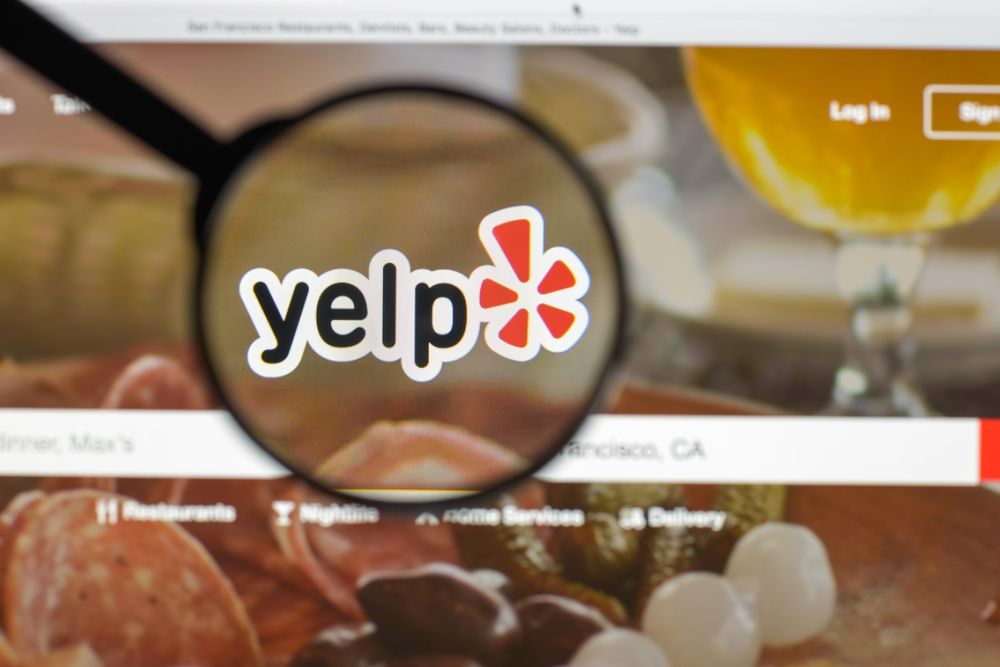
That sinking feeling in your stomach. You just checked your Yelp page and saw a new one-star review. It feels personal, unfair, and you can already imagine potential customers clicking away.
Your first thought is probably, how do you remove Yelp reviews? It’s a question thousands of business owners ask themselves every day. The good news is that you have options, but it’s not always as simple as hitting a delete button.
You need a clear plan to handle this, because how you remove Yelp reviews, or at least how you manage them, can make all the difference. How you handle a single bad Yelp review can define your brand’s commitment to customer service and is a critical part of your reputation management strategy.
Yelp has become a powerful force for local businesses. A glowing review can bring in a flood of new customers. But a negative yelp review can feel like a direct hit to your reputation, something you’ve worked so hard to build.
It’s totally normal to want that bad review gone, vanished forever. A single bad Yelp experience shared online can overshadow dozens of positive reviews. But Yelp has its own rules and processes, and understanding them is the first step to finding a solution.
Table of Contents:
- Why You Can’t Just Delete a Yelp Review
- So, How Do You Remove Yelp Reviews by Reporting Them?
- What if Reporting the Review Doesn’t Work?
- Proactive Reputation Management: Your Best Defense
- What About Legal Options for Defamatory Reviews?
- Conclusion
Why You Can’t Just Delete a Yelp Review
So, you want to get rid of that nasty comment. Unfortunately, Yelp doesn’t give business owners a ‘delete’ button. You can’t just log in from your Yelp business account and erase comments you don’t like.
Think about it from a user’s perspective. If businesses could scrub all their negative feedback, Yelp would lose all its credibility. It would just be a platform for glowing, potentially fake reviews, making it impossible for consumers to make informed decisions.
Yelp’s entire business model depends on maintaining a platform for authentic customer opinions, both good and bad. This commitment to unfiltered consumer voices means review removal is a structured, and sometimes difficult, process. Their platform is built on trust, and that trust comes from showing the full picture of customer experiences, including bad Yelp experiences.
Understanding Yelp’s Role as a Platform
Yelp positions itself as a publisher of third-party content, not the creator of it. This distinction is important. Because of protections under Section 230 of the Communications Decency Act, they generally are not liable for the content posted by their users.
This legal shield gives them broad discretion over what stays and what goes. They see their job as hosting a conversation, not moderating it to favor businesses. So their focus is on whether a review breaks their content guidelines, not whether you disagree with the customer’s opinion.
This means their motivation is to protect the integrity of all online reviews on their platform. They want users to see a mix of experiences to get an accurate picture. This is why their review removals process is so specific.
So, How Do You Remove Yelp Reviews by Reporting Them?
While you can’t just delete a Yelp review, you absolutely can report one that violates Yelp’s Content Guidelines. This is your primary and most direct path to getting a review taken down. Yelp’s team will then review your report and make a decision.
It’s not a guarantee, but it’s your best shot if the review is truly out of line. The key is knowing what actually counts as a violation. Just because a review is negative or you feel it’s unfair doesn’t mean it breaks the rules.
The success of your review removal request often depends on how clearly you can connect the online review to a specific policy violation. This requires a factual, evidence-based approach rather than an emotional one. Successfully learning how to remove Yelp reviews starts here.
What Qualifies for Removal?
Yelp has a specific set of rules that reviewers must follow. If a review crosses one of these lines, you have a solid case for reporting it. You need to identify a clear violation, not just a difference of opinion.
Here are the most common violations you should look for to delete Yelp reviews:
- Conflicts of Interest: The review was written by you, a current or former employee, a competitor, or someone paid to write fake reviews. This also includes reviews from someone promoting a rival business.
- Not Based on a Personal Experience: The reviewer is talking about someone else’s experience, a news story, or something they heard second-hand. Yelp reviews must be based on a first-hand consumer experience.
- Inappropriate Content: This includes threats, hate speech, harassment, lewdness, or other graphic details that are not relevant to a consumer experience. This is one of the quickest ways to get a bad review removed.
- Private Information: The review contains someone’s full name, phone number, address, or other private details. Yelp takes this very seriously to protect user privacy and will often act swiftly.
- Promotional Content: The review is just an ad for another business or contains commercial content. This is essentially spam and is not a legitimate review.
- Irrelevant Content: The review is a rant about a business’s political ideologies, employment practices, or other matters that don’t address the core of the consumer experience. Bad Yelp reviews must be relevant to be considered.
Yelp outlines all of these in their official Content Guidelines. Take a few minutes to read through them carefully. Matching the negative Yelp review to a specific violation is the most important part of your report.
You can’t just say “I don’t like this,” you need to prove it breaks a rule. The more specific you are in your report, the higher your chances of success. Document everything you can to support your claim for review removals.
The Step-by-Step Process for Reporting a Review
Found a review that breaks the rules? Great. Now it’s time to report it. The process is fairly simple, and you can do it directly from your business account.
- Log in to your Yelp for Business account. This is your central hub for managing your Yelp presence and the first step to delete negative Yelp reviews.
- Go to the ‘Reviews’ section of your account. You’ll see a list of all the online reviews left for your business, including both recommended reviews and those that are not.
- Find the review you want to report. Scroll to locate the specific bad review you believe violates the terms of service.
- Click the three dots (…) and select ‘Report Review’. This will open a new window with reporting options. A successful remove click is the goal.
- Choose the best reason for your report. Yelp gives you a dropdown list of violation types. Pick the one that most accurately fits the situation.
- Add a brief explanation. In the text box, clearly and concisely explain why the review violates Yelp’s policy. Stick to the facts. For example, “This reviewer mentions they heard from a friend, which is a second-hand experience and not a personal one.” Avoid emotional or angry language.
After you submit your report, you have to wait. Yelp’s moderators, who often operate on Pacific Time (PT), will investigate. The average wait time for a decision is usually a few business days, but it can vary.
You will get an email with a review update from their decision. If they agree the review violates their policies, they’ll remove it. If not, the review stays up, and you’ll need to consider other reputation management strategies.
What if Reporting the Review Doesn’t Work?
It’s a frustrating moment. You’ve sent your report, explained why the review is unfair, and Yelp replies saying it doesn’t violate their policies. It can feel like you’ve hit a brick wall, but don’t give up.
You still have a couple of other paths to explore. It’s important to remember that Yelp’s moderators are looking for black-and-white rule violations. Matters of opinion, even if they feel completely wrong to you as a business owner, are usually not something they will act on.
This is when your strategy needs to shift from review removal to damage control and turning a negative into a potential positive. How you handle these next steps can have a huge impact. This is a crucial part of your business support efforts.
The Power of a Public Response
Even if the review stays, your response matters. A calm, professional, and helpful public response can completely change how potential customers see the situation. It shows you’re engaged, you care about customer feedback, and you’re willing to make things right.
Here is a simple framework for a great response:
- Thank the reviewer. Even if the review is harsh, start by thanking them for their feedback. It shows professionalism from your Yelp account.
- Apologize for their bad experience. You don’t have to admit fault, but you can express regret that they were not satisfied. A simple “I’m sorry to hear your experience didn’t meet your expectations” works well.
- Address the specific issue briefly. Don’t get into a long, defensive argument. Briefly and factually address their main complaint. If they were wrong about something, you can gently correct them without being accusatory.
- Take the conversation offline. This is the most important step. Provide a way for them to contact you directly, like a phone number or email address, to discuss the issue further. This shows other readers that you are proactive in solving problems.
A great public response can sometimes do more for your reputation than getting the review removed. It shows future customers that even if something goes wrong, you are a business that listens and takes action. Many customers read how a business responds to negative Yelp reviews to gauge their level of customer service.
Can a Customer Edit or Remove Their Own Review?
Yes, and sometimes this is your best option. After you’ve responded publicly and reached out privately to resolve the issue, a customer might be willing to change their mind. A user can easily go into their Yelp account and delete Yelp comments they’ve made.
If you’ve truly solved their problem and provided excellent customer service after the fact, they might update their review to reflect that. A customer updating a one-star review to four stars with a note about your great follow-up can be even more powerful than having no review at all. It tells a story of a business that genuinely cares and can turn bad Yelp reviews into success stories.
Don’t be afraid to ask, politely. After you’ve fixed their problem, you could say something like, “We’re so glad we could resolve this for you. If you feel your experience has changed, we’d be grateful if you’d consider updating your review.” The worst they can say is no, but a positive resolution often leads to a positive review update.
Proactive Reputation Management: Your Best Defense
The most effective long-term strategy isn’t just reacting to negative Yelp reviews; it’s proactively building a strong positive presence. The goal is to generate so many good reviews that a single bad Yelp review becomes insignificant. This is the heart of effective online reputation management.
Instead of focusing solely on how to delete negative Yelp reviews, shift your energy toward cultivating a positive atmosphere. Provide exceptional service that naturally encourages customers to share their great experiences. A steady stream of positive feedback is the ultimate shield against occasional negativity.
Encourage Happy Customers to Share Their Experience
You should actively encourage satisfied customers to leave a review. This doesn’t mean offering incentives, which is against Yelp’s terms and can get you penalized. It simply means making it easy for them to share their thoughts.
You can do this by placing Yelp signage in your business or adding a link to your Yelp page in your email signature. You can also verbally mention it at the end of a positive interaction. Just asking, “We’re on Yelp and appreciate the feedback,” can lead to more positive reviews.
Think about how the Yelp Elite squad finds businesses to review; they often look for places with engaged management and happy customers. By fostering this environment, you attract more high-quality reviews. Many business success stories on the Yelp Business Blog start with this simple step.
Leverage Yelp’s Tools for Business Owners
Yelp offers several tools designed to improve the customer experience, which can prevent bad reviews before they happen. For example, restaurants can use Yelp Reservations or Yelp Guest Manager. These tools can help manage expectations and streamline operations.
Using the Yelp Guest Manager, you can accurately quote the average wait time for a table. If you can track the PT average wait for customers, you can prevent one of the most common complaints. Reducing customer wait time directly leads to fewer bad reviews.
Engaging with these tools shows you’re an active and attentive business owner. It signals to both customers and Yelp that you care about your service. Check the Weekly Yelp for business success tips and updates on new tools.
What About Legal Options for Defamatory Reviews?
Sometimes, a negative review crosses the line from opinion into defamation. This is a serious accusation. Defamation means a false statement of fact was published that harmed your business’s reputation.
Note the keywords here: false and fact. An opinion like “the food was tasteless” is not defamation. But a statement like “the chef spat in my food” is a statement of fact that, if false, could be defamatory.
Going the legal route to remove Yelp content is expensive, time-consuming, and should be considered a last resort. Before you even think about this, you should consult with a lawyer who specializes in internet law or defamation. This is not a path to take lightly, and it’s rare that you’ll need to remove negative reviews this way.
A lawyer can help you understand if you have a real case and what your options are. They might suggest sending a cease and desist letter to the reviewer. In very rare cases, a court order could be obtained to compel Yelp to remove a review that a judge has deemed defamatory.
Yelp has stated its policy on its website that it will review court orders regarding defamatory content; you can learn more by checking their investor relations or legal pages. But remember, this is a very high bar to clear and an expensive process to initiate. You need to be certain that the content is truly defamatory before starting down this road.
Conclusion
So, we’ve walked through the question of how do you remove Yelp reviews. While you can’t just delete a bad review, you are not powerless. Your best strategy starts with thoroughly understanding Yelp’s Content Guidelines and reporting clear violations to initiate a review removal.
If that doesn’t work, crafting a thoughtful, professional public response and reaching out to the customer directly can often turn a negative situation into a positive one. Responding well can sometimes be more beneficial than the initial attempt to remove the review. It showcases your business’s character and commitment.
While legal action is a possibility for truly defamatory content, it’s a complex and costly path. In the end, the best defense against negative reviews is consistently providing excellent service that leads to an overwhelming number of positive ones. That’s the real secret to a stellar online reputation and the best answer to how you handle bad reviews.












